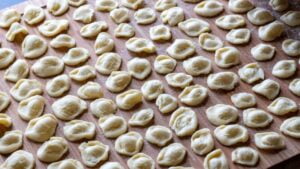.
La nascita del Brunello di Montalcino risale all’Ottocento, quando alcuni agricoltori montalcinesi iniziano a sperimentare la produzione di un vino rosso con le uve di una vite tradizionalmente coltivata nella zona. Una vite chiamata “Brunello” o “Brunellino” che, verso la metà dell’Ottocento, viene identificata come una varietà del Sangiovese. Un’uva molto pregiata perché capace di produrre vini da lungo invecchiamento cioè vini rossi di altissimo pregio. Il padre precursore del Brunello di Montalcino fu certamente Clemente Santi. Nel 1869 un suo Vino Scelto (Brunello), della vendemmia 1865, fu premiato con medaglia d’argento dal Comizio Agrario di Montepulciano. Negli anni successivi il Brunello ottiene altri importanti riconoscimenti internazionali battendo i rossi francesi persino a Parigi e a Bordeaux. Per molti anni il Brunello rimase una rarità destinata a pochi raffinati intenditori. E’ solo nella seconda metà del Novecento che, da una prelibatezza per pochi, si trasforma in un simbolo mondiale del migliore made in Italy. Con la nascita delle DOC, il Brunello vive una fase da protagonista ed è nel gruppo dei primi otto vini a cui viene attribuita la denominazione di origine. Nel 1966 il Brunello di Montalcino diventa un vino Doc e l’anno dopo istituisce il suo Consorzio. Nel 1980 è la prima Denominazione di Origine Controllata e Garantita DOCG e da quel momento tutte le sue bottiglie vengono chiuse da un contrassegno di Stato che garantisce la loro provenienza. Tuttavia la produzione del Brunello è ancora troppo piccola per affermarsi su scala internazionale. La prima cantina con una vera rete commerciale è degli anni ‘70 ma il Brunello conquista il mercato mondiale solo dopo il 1980 anche attraverso una crescita del numero delle cantine e delle bottiglie prodotte. Montalcino fa da battistrada anche al turismo del vino italiano con le prime cantine attrezzate per visite guidate e un intero territorio che ogni anno riceve migliaia di visitatori da tutto il mondo. Moltissimi riconoscimenti comprovano la qualità del vino: nel 1999 la prestigiosa rivista statunitense “Wine Spectator” inserisce un Brunello fra i 12 migliori vini del XX° secolo e nel 2006 incorona un Brunello in cima alla classifica mondiale.
As a designer of experience, Federica Piccoli focuses on the inter-connection between land, culture, food and wellbeing. Starting from the personality of the producer/locations, the sensory and emotional experiences are focused on recovering personal rhythm and perception of time and space, and on finding the starting point to fully live blissful moments. "The seven senses of wine", "Tasting ∞ Meditation", and "Esperienze immersive di degustazioni erranti" are examples of designed paths. Wine, chocolate, food and well-being is her passion. She is very active in the land of wine in Italy, from Piedmont Monferrato and Barolo down to Puglia Primitivo passing through Chianti and Montalcino in Tuscany. Federica Piccoli lived abroad for many years, these experiences made her appreciate more and more the importance of appreciating little moments of joy through high quality food and wine that she found in her homeland: Italy. She created a format for wine tasting through the cellars where the wine is produced that one must do at lest once in a lifetime.
Le orecchiette sono una pasta tipica della Puglia, regione del sud Italia. Il loro nome deriva dalla loro forma, che ricorda un piccolo orecchio. L'orecchietta ha la forma di una cupoletta, con il centro più sottile del bordo e con la superficie ruvida. Come altri tipi di pasta, le orecchiette sono fatte con semola di grano duro e acqua. Le uova sono usate raramente. Nella cucina casalinga tradizionale del sud Italia, la pasta viene arrotolata, quindi tagliata a cubetti. Ogni cubo viene pressato con un coltello, trascinandolo sul tagliere e facendolo arricciare (facendo un cavatello). La forma viene quindi invertita sopra il pollice. Le orecchiette si mangiano con broccoli, cime di rapa, cozze e funghi. Ogni famiglia pugliese ha la sua ricetta che si tramanda di madre in figlia. Secondo illustri studiosi dell'enogastronomia pugliese le orecchiette avrebbero avuto origine nel territorio di Sannicandro di Bari, durante la dominazione normanno-sveva, tra il XII e il XIII secolo. Nel cuore del centro storico di Bari c'è una via ribattezzata “la via delle orecchiette” o “via delle orecchiette”. La via in questione si chiama ufficialmente Strada Arco Basso, caratterizzata appunto da un piccolo tunnel che un tempo attraversato conduce alla più antica tradizione di Bari Vecchia, quella della produzione delle fantastiche e popolarissime orecchiette baresi. Le donne preparano le orecchiette chiacchierando e aiutandosi. Hanno un sapere antico che si tramandano di madre in figlia, di nonna in nipote. Ciascuna famiglia conserva i propri piccoli segreti per la lavorazione delle orecchiette che avviene davanti alla gente e sono una vera attrazione del centro storico di Bari, oltre a rappresentare uno spaccato originale della quotidianità pugliese. La buonissima pasta fresca (poi lasciata asciugare su banchi di legno) può essere acquistata anche dalle stesse signore; queste donne, infatti, per permettere ai turisti di portare a casa il gusto tipico delle orecchiette baresi, mettono la pasta fresca in semplici sacchetti di plastica così da permettere alle persone di tornare a casa con un gustoso “ricordo” pugliese. Orecchiette are a pasta typical of Apulia, a region of Southern Italy. Their name comes from their shape, which resembles a small ear. An orecchietta has the shape of a small dome, with its center thinner than its edge, and with a rough surface. Like other kinds of pasta, orecchiette are made with durum wheat and water. Eggs are rarely used. In traditional Southern Italian home cooking, the dough is rolled, then cut into cubes. Each cube is pressed with a knife, dragging it on the board and making it curl (making a cavatello). The shape is then inverted over the thumb. Orecchiette are eaten with broccoli, turnip tops, mussels and mushrooms. Each Apulian family has its own recipe that is handed down from mother to daughter. According to distinguished scholars of Apulian food and wine, orecchiette would have originated in the territory of Sannicandro di Bari, during the Norman-Swabian domination, between the 12th and 13th centuries. In the heart of old town of Bari there is a street renamed “the street of orecchiette” or “street of orecchiette”. The street in question is officially called Strada Arco Basso, characterized precisely by a small tunnel that once crossed leads to the oldest tradition of Bari Vecchia, that of the production of the fantastic and very popular orecchiette from Bari. The women prepare the orecchiette by chatting and helping each other. They have an ancient knowledge that is handed down from mother to daughter, from grandmother to granddaughter. Each family keeps their own little secrets for the processing of orecchiette that takes place in front of the people and are a real attraction of the historic center of Bari, as well as representing an original cross-section of Apulian everyday life. The delicious fresh pasta (then left to dry on wooden counters) can also be purchased by the ladies themselves; these women, in fact, to allow tourists to take home the typical taste of orecchiette from Bari, put the fresh pasta in simple plastic bags so as to allow people to go home with a tasty Apulian "memory". The delicious fresh pasta (then left to dry on wooden counters) can also be purchased from the ladies themselves; these women, in fact, to allow tourists to take home the typical taste of orecchiette from Bari, put the fresh pasta in simple plastic bags so as to allow people to go home with a tasty Apulian “souvenir”.
Anyone can be a Heritage Ambassador. Help take our past into the future. Spread the word and generate revenue. Make heritage your business and earn with your passion for art and culture. ArtAcadia.org is an umbrella organization for everything pertaining to our heritage and respective cultures. Providing a platform for Heritage Ambassadors, to help take our past into the future. We are a passionate community that is compiling a comprehensive global directory and cultural map. Facilitating networking, training, work opportunities, events and marketplace.
Taking our past into the future with Carolina Reviglio! Carolina enjoyed a carefree childhood in the Piedmont countryside. With many cousins and friends, the passion for culture was instilled from an early age. Surrounded by beauty and art in the family mansion Cimena, expertly curated by her grandmother namesake, Carolina. On the paternal side of the family, her Venetian grandmother was equally influential. The unique character and rich culture of Venice, epitomizes Carolina. While travelling often, she feels most at home, in the isles of Venice. Schooled in Italy and the United States, lived in provinces throughout the length of Italy, Carolina considers herself truly Italian, with an international vision. “My country is rich in heritage, but poor in the pocket to keep it so. It saddens me to see so many buildings in a state of disrepair.” She has honed the skills of renovation and interiors of historic buildings, since 1987. Learning by trial and error, spurned on by failure and ultimate success, Carolina has grown and prospered. Now is the time to give back. Helping artisans of all disciplines to find work and ply their trade with pride. Matching projects to professionals and vice versa. As Heritage Doyenne, Carolina’s primary contribution to this unique initiative, is to encourage the participation of Heritage Ambassadors. This cause is yet another open avenue, to take our past into the future. By intertwining culture and heritage, to create more synergy. “Only once we fully understand where we come from… and truly appreciate our heritage… can we imagine a fabulous future filled with the richness of our past. Life is ours to design!” ~ Carolina Reviglio
.
.
















